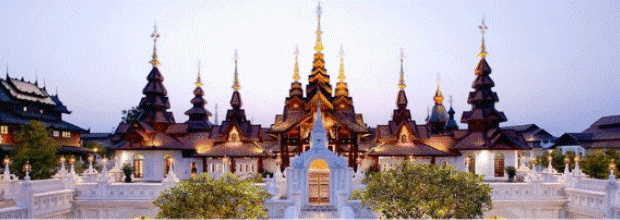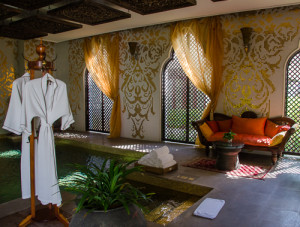My Precious,
I arrived at the Dhara Dhevi as dusk in Chiang Mai unfolded into shades of luscious lavender. I crossed the ‘singing bridge’ – a tribute to honor the Dhara Dhevi’s medieval design that heralds arriving guests – and continued across a cobblestone road towards a white staircase. White walls, white arches and tasteful white filigree flanked the staircase. More white structures zigzagged behind. They ascended boldly, each in support of teakwood rooftops now darkened from the declining light. “Stunningly ‘chiaroscuro’,” you and I would both comment.
Luminous with evening light, their steeples arose stacked and staggered, crowned with gold spires like an ornate wedding-cake. They perforated what became a brilliant violet sky. What a delight, and only the first of The Dhara Dhevi’s myriad experiences I soon learned.
“Sawadee Ka!” A tuberose lei and the traditional Thai ‘wai’ – folded hands together at the heart – greeted me at the Reception Pavilion. Wafts of lemongrass gently infused the air. Did I say The Dhara Dhevi has re-imagined the medieval Northern Thai Kingdom of Lanna, the ‘Land of a Million Rice Fields’? It is a wildly beautiful mélange of Burmese, Chinese, Laotian and Northern Thai influences that grace the villas, moats, gardens, marketplaces, lotus ponds, rice fields and pools.
Consider this, Dear, the medieval Thai Kingdom of Lanna and the Italian Renaissance city of Florence were contemporaries: both world-class art centers, models of political stability and fundamentally attuned to chiaroscuro lighting. The luxurious Dhara Dhevi honors its past in glorious style, as does Florence. It is a sanctuary based on an actual royal palace blueprint, befitting of any star goddess. Did I mention that ‘dhara dhevi’ is Sanskrit for‘star goddess?’ You know, of course, you are my only star.
Two distinct styles define the spacious rooms. Anglo-colonial décor reigns in the large Colonial Suites. Of course you will recall that the English never conquered Thailand, only its neighbor Myanmar which they renamedBurma. Lanna-styled villas feature medieval exteriors (several are converted antique rice barns) while the glamor of golden teakwood enhances the interiors’ ultra-modern luxuries. By design, the best of both worlds reign at the Dhara Dhevi.
I head to morning yoga class at the award-winning Spa. Ornamental flame-tips adorn each of the seven-teakwood roof tiers. The imperial Dhara Dhevi Spa, a breathtaking model of a 19th century Mandalay Palace, is adorned with richly-carved Hindu deities and sleekly-simple Buddhist statues. The former’s sensuality and latter’s quiet assure me that balance is the priority here, my friend. The Spa features 22 treatment rooms.
On to a ride across the village by bicycle (or simply a stroll along the glorious pathways) and I visit the rice paddies to meet Boonchop, the resident albino buffalo. The same indigo-clad farmers who attend the rice fields also guide Boonchop. These paddies fulfill the resort’s total needs. All excess is donated to a nearby temple, in which you can opt to partake, and make merit for your Buddhist self, or simply your own spirit.
Throughout this resort, I can swim in two substantial pools, learn Northern Thai folk art, shop in the medieval village or opt to chill in the plush library. But I am wisely guided to study Thai cooking under Chef Aum. Her classes hold forth in a beautiful modern kitchen by the Old Rice Barn, after an early morning market jaunt. Her lessons in style and substance remain a brilliant keepsake. We must do this together, Mon Chou!
The Dhara Dhevi is a mélange of unparalleled luxury, art, architecture and living history. The hotel pays 10% commission on room bookings only. Next time, no postcard … Just be by my side!
Dhara Dhevi, www.dharadhevi.com


